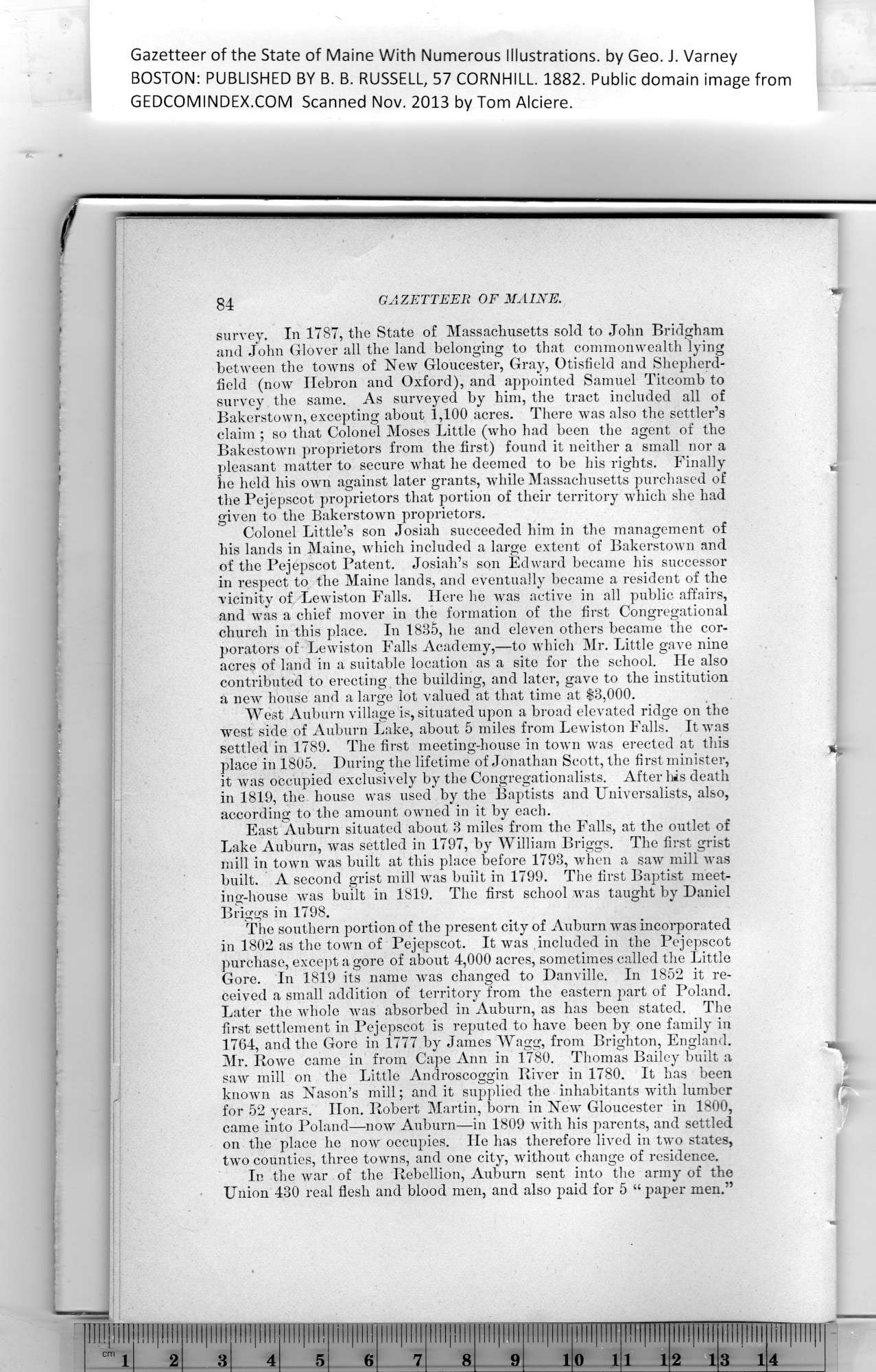|
Gazetteer of the State of Maine With Numerous Illustrations, by Geo. J. Varney
BOSTON: PUBLISHED BY B. B. RUSSELL, 57 CORNHILL. 1882. Public domain image from
84 GAZETTEER OF MAINE.
survey. In 1787, the State of Massachusetts sold to John Bridgham
and John Glover all the land belonging to that commonwealth lying
between the towns of New Gloucester, Gray, Otisfield and Shepherd-
field (now Hebron and Oxford), and appointed Samuel Titcomb to
survey the same. As surveyed by him, the tract included all of
Bakerstown, excepting about 1,100 acres. There was also the settler’s
claim ; so that Colonel Moses Little (who had been the agent of the
Bakestown proprietors from the first) found it neither a small nor a
pleasant matter to secure what he deemed to be his rights. Finally
he held his own against later grants, while Massachusetts purchased of
the Pejepscot proprietors that portion of their territory which she had
given to the Bakerstown proprietors.
Colonel Little’s son Josiah succeeded him in the management of
his lands in Maine, which included a large extent of Bakerstown and
of the Pejepscot Patent. Josiah’s son Edward became his successor
in respect to the Maine lands, and eventually became a resident of the
vicinity of Lewiston Falls. Here he was active in all public affairs,
and was a chief mover in the formation of the first Congregational
church in this place. In 1835, he and eleven others became the cor-
porators of Lewiston Falls Academy,—to which Mr. Little gave nine
acres of land in a suitable location as a site for the school. He also
contributed to erecting the building, and later, gave to the institution
a new house and a large lot valued at that time at $3,000.
West Auburn village is, situated upon a broad elevated ridge on the
west side of Auburn Lake, about 5 miles from Lewiston Falls. It was
settled in 1789. The first meeting-house in town was erected at this
place in 1805. During the lifetime of Jonathan Scott, the first minister,
it was occupied exclusively by the Congregationalists. After bis death
in 1819, the bouse was used by the Baptists and Universalists, also,
according to the amount owned in it by each.
East Auburn situated about 3 miles from the Falls, at tbe outlet of
Lake Auburn, was settled in 1797, by William Briggs. The first grist
mill in town w7as built at this place before 1793, when a saw mill was
built. A second grist mill was built in 1799. The first Baptist meet-
ing-house was built in 1819. The first school was taught by Daniel
Briggs in 1798.
The southern portion of the present city of Auburn was incorporated
in 1802 as the town of Pejepscot. It was included in the Pejepscot
purchase, except a gore of about 4,000 acres, sometimes called the Little
Gore. In 1819 its name was changed to Danville. In 1852 it re-
ceived a small addition of territory from the eastern part of Poland.
Later the whole was absorbed in Auburn, as has been stated. The
first settlement in Pejepscot is reputed to have been by one family in
1764, and the Gore in 1777 by James Wagg, from Brighton, England,
i Mr. Rowe came in from Cape Ann in 1780. Thomas Bailey built a
i saw mill on the Little Androscoggin River in 1780. It has been
! known as Nason’s mill; and it supplied the inhabitants with lumber
for 52 years. Hon. Robert Martin, born in New Gloucester in 1800,
came into Poland—now Auburn—in 1809 with his parents, and settled
on the place he now occupies. He has therefore lived in two states,
two counties, three towns, and one city, without change of residence.
In the war of the Rebellion, Auburn sent into the army of the
Union 430 real flesh and blood men, and also paid for 5 “ paper men.”
PREVIOUS PAGE ... NEXT PAGE
This page was written in HTML using a program written in Python 3.2
|
